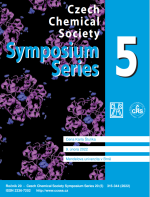Aplikace transesterifikační derivatizační reakce pro GC-MS analýzy
DOI:
https://doi.org/10.54779/ccsss20220319Klíčová slova:
derivatizace, GC-MS, lipidy, oleje, transesterifikaceAbstrakt
This paper is focused on study of the concentration of the basic catalyst in methanol on the yield of the derivatization transesterification reaction of triacyglycerols. Potassium hydroxide and sodium hydroxide solutions were used as basic catalysts. Triacylglycerols were transesterified, rapeseed oil was used as a sample. Triacylglycerols were converted to methyl esters of fatty acids, which were subsequently determined by GC-MS where the peak areas were monitored, because they represent the yield of the formed fatty acid methyl esters, namely palmitic, oleic, linoleic and stearic acids. The highest yield of transesterification of the oil to methylesters of fatty acids was found for a concentration of 3.0 mol dm–3 for KOH and 2.0 mol dm–3 for NaOH. At higher catalyst concentrations, a predominant side-reaction, saponification, was observed, which decreased the overall yield of fatty acid methyl esters.




